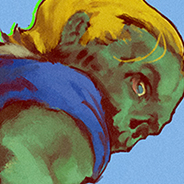Warcry is the best game Games Workshop has published in a decade.
“Between the time when the oceans drank Atlantis and the rise of the sons of Aryas, there was an age undreamed of... Let me tell you of the days of high adventure!”
I recently got back into Warhammer 40,000 with the largely successful 8th edition, and then dove into the skirmish version, Kill Team, when that was resurrected more recently. Compared to Warhammer 40,000, Kill Team needed fewer models, less space to play, and was (theoretically) quicker. Its job as a gateway to Warhammer 40,000 became increasingly apparent, though: the models were all drawn from that game and stat blocks, abilities, and point values were shifted over directly. Over time the rules became bloated, as they were both effectively those of Warhammer 40,000 and specific extra details for Kill Team.
Kill Team was unfocused, even the campaign mode didn’t really provide a reason why small, elite teams would be fighting each other over again, and a punitive increase in cost for the models meant you were usually better off scrapping team members who built up experience.
Where Kill Team had a huge brief, with every race in the Galaxy sending their own elites and commanders to play, Warcry wrangles it down to an easy-to-grasp high concept: Chaos warbands trying to win the approval of Archaon the Everchosen in the vast wasteland - the Bloodwind Spoil - surrounding his stronghold. This immediately ratchets up the narrative, giving us all a reason to be in the same place slapping each other about, and is so fundamentally… well, Warhammery (totally a word I've checked - Iain). Chaos warbands, an endless wasteland, Archaon, hitting people with hammers. It draws on vintage publications like Realm of Chaos, or Path to Glory, though is considerably less arcane than either.
This classic Warhammer feel runs like a vein of heavy metal right through the game. The model and terrain design feels like it’s dropped right out of the 1980s: inspired by Frazetta fantasy art, with oiled biceps gleaming at you straight out of Conan and a warband who are so metal they’ve flayed their own faces off to wear as belt buckles. There’s even a gloriously camp live action trailer for the game up on the WarhammerTV YouTube channel that I simply cannot recommend enough.

We even have plenty of women characters amongst the warbands! Admittedly some are wearing chainmail bikinis, but then, so are the men. I also appreciate the decision to split the gangs by the eight winds of magic rather than by the four chaos gods; it would have been easy to have stuck to the familiar mutant design, but we here have unique and flavourful bands, and honestly characters that are easier to sympathise with than the usual armoured warriors festooned with skulls and tentacles.
All in all, it’s less of the ‘heroic’ high fantasy that latter day Warhammer Fantasy and Age of Sigmar drifted into. It feels, I think, a little how you remember Warhammer used to feel.
The major departure from this classic Games Workshop atmosphere is in the gameplay. Again, where Kill Team zoomed in on Warhammer 40,000 and added detail, Warcry takes things out in order to focus on more cinematic action and easily-read results. There are alternating activations for your warband, and only 4 actions available: move, disengage, wait, attack. Attacks are boiled down to a single roll, with no defensive roll at all, and the mechanics of these can be explained in 30 seconds. And that’s… it. Seriously. Reading this paragraph you basically know how to play Warcry.
While it feels like this would over-simplify what’s meant to be a strategic game, in practice there is still variation between weapons and more weight placed on order of activations, combining abilities, and, maybe most of all, positioning. The expanded damage and hitpoints of the characters means you no longer have tough characters with a host of defensive rolls that soak up attacks with no impact, but there’s still scope for attacks to either fumble or smash home. Games Workshop have killed the roll-to-hit, roll-to-wound, armour-save attack sequence that’s haunted so many of their games and after playing Warcry, I do not miss it. As my regular play partner said to me, it’s rare for an activation (especially with an attack action) to pass by without anything meaningful happening.
The Hero Phase is maybe emblematic of the ‘simple and elegant’ ethos of the game, and absolutely my favourite part. To decide who gets initiative on a turn, each player rolls six dice and separates them into number values. This leaves you with some numbers which occur only once (singles), some which occur twice (doubles), and so on. The player with the most ‘singles’ gains initiative, with a roll off in the case of a tie.
Straightforward so far? Okay, so each warband also has access to a handful of special abilities that can be paid to trigger during your turn with the remaining doubles, triples, or quads in your pool. Sometimes the value of the dice matters, sometimes not. You can even use a triple as a double if you really need a crucial ability to fire this turn. These abilities have cool cinematic effects, and can have a real effect on the flow of the battle. As a great example, the Untamed Beasts’ First Fang can pull people towards them, Mortal Kombat-style, with a spear throw. Use it to yank people off ledges, into range for other fighters, even pull them away from objectives to secure victory.

From the moment you start playing this dice system sets up a nice trade off: if you roll more singles, you’ll win initiative, if you roll fewer singles you’re able to use more abilities during the turn. With six 6-sided dice, you’ll almost always have at least one ability you can use, and usually you’ll have two. These dice are lost at the end of the turn which encourages you to use the abilities, and rerolls are shunted into a campaign-specific mechanic so you don’t waste your ‘having fun’ resource doing something boring.
The final touch is the Wild Dice. Each player gets a single die every turn that can be added to your pool as any number, or stored for a future turn. With this, the Hero Phase becomes a thorny pre-turn push-your-luck and planning phase. The player with initiative has to use their dice first, so maybe they end up over committing to extra singles to guarantee initiative, leaving their opponent with more dice to turn singles into doubles… Or maybe they get greedy and turn a triple six into a quad six for a powerful ability, leaving their opponent free to seize the initiative. You can even sacrifice initiative (a tactical discussion in itself) to grab an extra double.
The system takes a minute to explain and the fun of it becomes apparent the very first time you look down at your dice pool and get handed a wild die. It’s simple, and it’s elegant. The rules build upwards on these strong foundations, creating a solid tower of a ruleset.

I don’t want to go into detail for the other mechanics, but I do want to mention the campaign mode. I’ve played a lot of Games Workshop campaign-based games – Necromunda, Mordheim, Bloodbowl, even Path to Glory – and Warcry makes a change that’s deceptively simple for how drastic it is: warbands don’t all compete for a single goal. Each Warband progresses independently towards a single goal (‘quest’) for your team.
This is just *chef kiss* brilliant, it does so much to make campaign play better. It gives character to your team, provides you natural break points (quests all are 12 games long, after which you either start a new quest or start a new team), and, crucially, means you don’t need to organise a huge league in order to play. It also largely removes problems of runaway gangs, with dominated territory and ‘glory’ reset after finishing a quest. It’s such a simple twist on the standard campaign format Games Workshop have followed for literally decades I can’t believe I never saw it.
I do have a couple of criticisms. Firstly, it’s sad to see the box only has six dice of three different colours. Typically you use at least seven of these in the Hero Phase. An extra six white dice to keep for rolling for regular attacks would open up the game for new players. Similarly it’s a shame that the instructions for the terrain don’t detail how to build all the pieces shown on the terrain cards. There’s lots of guides on how to do this online, but that’s not necessarily the first place a new player is going to look!

These are fairly nerdy nit-picks, I appreciate, but they add a couple of little extra barriers for a game that’s done so well to break them down. And these are a shame because, as a whole, Warcry is essentially the classic Warhammer experience in a single box. It gives you everything you need to play, gives you some of the rules basics if you want to escalate to playing Age of Sigmar in the future, not to mention the terrain to play on. You can even download rules to use the warbands in games of Age of Sigmar for free from the Games Workshop website.
While Warcry isn’t a detailed skirmish game like Kill Team or a successor to Mordheim, it’s a fast-paced and slick skirmish game that doesn’t compromise on strategic depth, inspired by classic Games Workshop titles like Realms of Chaos and Path to Glory. It’s the perfect jumping in point for someone who hasn’t played a game like this before, and a great choice for anyone put off by the fiddliness of Kill Team.
Peter Hopkins is a guest writer. He’s been playing and collecting Games Workshop games for around two decades. His podcast is Drawn to the Flame, and can be found in the usual podcast places.
This review is based off a copy of Warcry that Peter bought with his own money. I can't say whether it is hard earned or not.
 Games
Games How to resolve AdBlock issue?
How to resolve AdBlock issue? 























